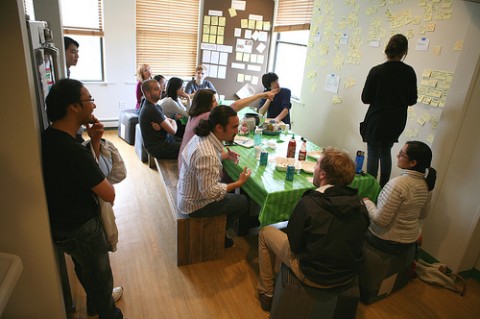Intuition, Iteration, and Group Visualization for Change
February 20, 2015 Leave a commentImportant considerations for collaborative social change work: What are considered “legitimate” ways of knowing and doing? Why? What does this allow? What doesn’t it allow?
I’m always interested to see diverse cognitive styles and preferences show up in the collaborative processes we help to design and facilitate at IISC. A classic difference is between those who bend more towards the analytical side of things and those who prefer to lead with intuition. This, of course, paints too stark of a dichotomy of what most people present overall, and context can often be a determinant in what people lead with. Nonetheless there are undeniable tensions that arise within groups about what constitutes “rigor” and “right method” for deriving what might be considered strategic insights. I would say that in many more “mainstream” (one might say “professional”) settings, it is often analysis and deference to some kind of “expert “that has a better chance of winning the day. And so I’ve been interested to come across a few resources that talk about and validate the place of intuition and iterative group visualization in coming up with good answers.
In a piece that appeared in the Harvard Business Review, Justin Fox writes about how instinct can beat analytical thinking. In particular, he lifts up the work of Gerd Gigerenzer from the Max Planck Institute for Human Development in Berlin, Germany. Gigerenzer’s research suggests that rational, statistical, analytical approaches work well in situations where one is able to calculate risk. The trouble, however, is that in many situations, decisions are made in considerable uncertainty, where risk and consequence are unknown because everything is quite dynamic.
“We need statistical thinking for a world where we can calculate the risk, but in a world of uncertainty, we need more.”
What Gigerenzer says can serve people well amidst uncertainty is instinct, intuition or “gut feeling.” In fact, he has found among leaders he has studied that 50% of all decisions made stem from some kind of gut sense, though interestingly he notes that many “would never admit this in public.” Furthermore, he pushes back on the big data craze, stating that big data provides a false sense of certainty in an unpredictable world. So it really comes down to context, and understanding that in situations of considerable complexity, which is often what we face in social change work, intuition can serve us well, even if many don’t feel comfortable with this truth or like to openly admit it. It is also probably important to note the cultural biases and social situated-ness that can privilege statistical/analytical ways of knowing, at the expense of marginalized yet valuable means.
The other resource I wanted to highlight is the above TED Talk by Tom Wujec (thanks to Jeanne Rizzo for the heads up on this) who shows in quite entertaining fashion how people can make sense of “messy” situations that they inherit or create through illustration and iteration. Specifically, he talks about a design challenge he has used through which he invites people to draw/map how to make toast. Now as silly as the exercise might seem, it actually reveals interesting things about the power of making ideas visual (and perhaps ultimately more tangible). Those who have dabbled in or regularly practice design thinking know about this, and yet I am still struck by how inviting people to draw and engage in an iterative group process in our work can send a fair number into very uncomfortable places, at times yielding disparaging remarks that we are not being “professional” or “rigorous” enough. Despite this, the evidence shows that collaborative visualization (including the use of our beloved “stickies”) can help with clarity, engagement and alignment.
"Because of social complexity, solving a wicked problem is fundamentally a social process." http://t.co/YIty1UoTw4
— Harold Jarche (@hjarche) February 15, 2015
I like how the tweet above from Harold Jarche (with a link to a great resource on Dialogue Mapping) summarizes what much of this post is trying to say. As social change efforts are mostly rooted in a context of considerable complexity, we are really talking about the realm of the social, which is often messy, for some people (at least initially) “slow,” and apparently inefficient. And really this is unavoidable, and ultimately we would say that it is not altogether undesirable, as success in a dynamic world is predicated certainly upon achieving results, but also building processes and relationships for the long haul, including collaborative skill rooted in caring. As such, it behooves change efforts to pull on a diversity of forms of expression and investigation, which also may test some of people’s underlying and as yet unexamined beliefs about about human nature and the nature of democracy. And that, in my humble opinion, is a very good thing and a central part of the work.
“Some of the things that matter most unfold in the same rhythm they always have. . . . The pace of life hasn’t changed, even if the pace of communication has. Do people fall in love more quickly? Do people trust each other more quickly? I work in my garden: You cannot make flowers bloom faster.”
